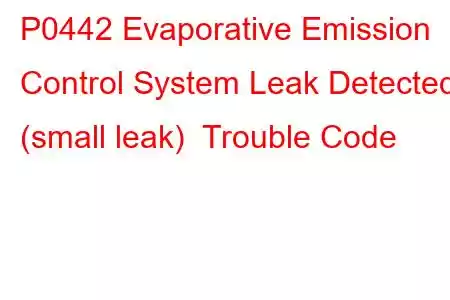P0442 Evaporative Emission Control System Leak Detected (small leak)
OBD-II Trouble Code Technical Description
Evaporative Emission Control System Leak Detected (small leak)
What does that mean?
This diagnostic trouble code (DTC) is a generic powertrain code, which means that it applies to many OBD-II equipped vehicles. Although generic, the specific repair steps may vary depending on make/model. This code is found on many makes including but not limited to Ford, GMC, Jeep, Dodage, Toyota, BMW, Chrysler, Subaru, etc.
The vehicle's PCM (powertrain control module) tests the evaporative emissions (EVAP) system for large and small leaks among other conditions. In the case of this DTC, it indicates a fuel vapor leak in the EVAP control system. It means a very small leak has been detected. In fact, the leak can be from a hole as small as 0.04" in diameter. The (EVAP) emission control system prevents the escape of fuel vapors from a vehicle's fuel system.
Fuel vapors are routed by hoses to a charcoal canister for storage. Later, when the engine is running a purge control valve opens allowing intake vacuum to siphon the fuel vapors into the engine to be burned. That results in decreased vehicle emissions.
Photo of a typical gas cap:
Symptoms
The only thing you will notice is the Malfunction Indicator Lamp (MIL) a.k.a. Check Engine Light will be illuminated. You likely won't notice any drivability problems although sometimes a fuel odor may be noticed.
Causes
A code P0442 most likely means one or more of the following has happened:
A loose or improperly affixed gas cap A non-conforming gas cap (i.e. not factory/original brand) A small leak/hole in a fuel vapor hose/tube Other small leak in EVAP system Faulty vent o-ring seal Defective vent valve Defective purge valve Defective leak detection pumpPossible Solutions
With a P0442, the most common DIY repair is to:
Remove and reinstall the gas cap, clear the codes, and drive for a day and see if the codes come back. Otherwise, replace the gas cap (we recommend an OEM original part, not aftermarket part), or Visually inspect the EVAP system for cuts/holes in tubes/hosesMore advanced troubleshooting steps include:
Using an advanced scan tool, perform an EVAP leak test Verify operation of the EVAP purge solenoid / valve Perform a smoke test to see where the leak isGenerally there are vehicle and model specific procedures for proper diagnosis of this DTC.
Other EVAP DTCs: P0440 - P0441 -P0443 - P0444 - P0445 - P0446 - P0447 - P0448 - P0449 - P0452 - P0453 - P0455 - P0456
Read: 48


